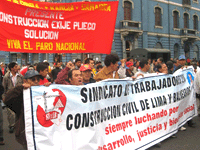
Alan Garcia
National protests rock Peru as President Alan Garcia navigates through an increasingly tumultuous labor and teacher uprising. Rejections of a free trade agreement with the US and neoliberal economic policies are at the heart of the national uprising which has left three people dead and several wounded.
Protests have stemmed from an increasing gap between the rich minority and the poor majority in the country. Most of Peru‘s population of over 27 million survives on less than a dollar a day. "What we have in Peru is economic growth without social development," a political analyst, Ernesto Velit, told Reuters.
 President Garcia, who in his election campaign promised he had learned from his disastrous mistakes in a previous presidency, is now experiencing a sharp decline in approval ratings.
President Garcia, who in his election campaign promised he had learned from his disastrous mistakes in a previous presidency, is now experiencing a sharp decline in approval ratings.
Miners, farmers, construction workers and teachers in Peru are demanding better wages and revisions to the country’s free trade agreement with the US. The international Manco Cápac airport in Juliaca, Peru was occupied by 5,000 workers who set fire to furniture and office equipment in the facility. Members of the Unified Trade Union of Education Workers of Peru (SUTEP) protested the passage of an educational reform law which teachers contend will privatize education and put hundreds of teachers out of work. Protesters are also demanding an assembly be organized to rewrite the country’s constitution so that Peruvians can "effectively recover their rights."
A train carrying tourists to Machu Picchu was pelted with stones thrown by local protesting campesinos. Police officers and one governor were taken hostage by strikers and transportation in many provinces has been at a standstill for days. The teacher strikes closed down 70 percent of the country’s schools, while other protesters blockaded roads and occupied government buildings.
Protesters in southern Peru held nine policemen hostage for six hours. Protest leaders wanted to exchange the hostages for 14 demonstrators who had been arrested. Meanwhile, 1,000 people blockading a major highway demanded the government invest in the region and expressed solidarity with the national teachers’ strike.
Ollanta Humala, a left wing candidate in the last elections against Garcia, has joined the strikers in hopes to rekindle a future bid for the presidency.
Panama and Bush’s Push for Allies in the Americas
On July 11th, Panama‘s National Assembly approved a free trade agreement with the US by a margin of 58 to 3. Proponents of the move say the agreement will help Panama grow as an exporter of goods to the US. Farmers and unions denounced the Assembly’s decision, explaining that Panamanian producers can’t compete with those in the US. Enrique Athanasiadis of the National Agriculture Organization said "This accord is a disaster for products and it benefits the oligarchy." Hundreds of activists convened outside government offices to protest.
Analysts see the recent push for US trade agreements with Peru, Colombia, Panama and South Korea as a growing part of US President Bush’s current agenda. One senior official in the Bush administration said, "The pro-trade community sees these four agreements as a united set and believe it’s important to pass them all. The ongoing effort is continuing to build and will ratchet up efforts toward building bipartisan majorities this fall."
The National Journal writes that “[Bush] administration officials are careful not to mention Venezuela or left-wing president Hugo Chavez, but they are clearly concerned about his moves toward nationalizing industries and his use of charisma and oil money to spread his message in the region.”
***
Benjamin Dangl is the author of The Price of Fire: Resource Wars and Social Movements in Bolivia, (AK Press, March 2007).

 President Garcia, who in his election campaign promised he had learned from his disastrous mistakes in a previous presidency, is now experiencing a sharp decline in approval ratings.
President Garcia, who in his election campaign promised he had learned from his disastrous mistakes in a previous presidency, is now experiencing a sharp decline in approval ratings. 